Auditing Report: Governance, Ethics, and Auditor Liability
VerifiedAdded on 2021/04/19
|13
|2919
|452
Report
AI Summary
This report provides a detailed analysis of auditing practices, focusing on the responsibilities of auditors in reviewing the governance of audit clients. It explores the requirements outlined in auditing standard ASA 135, emphasizing the importance of understanding internal controls and assessing risks. The report also examines governance issues at Commonwealth Bank and the recommendations made by ASIC. Furthermore, it applies the AAA ethical decision-making model to a scenario involving ethical dilemmas within an auditing firm. Finally, the report addresses the role of auditors, the statutory cap on liability, and the implications for audit firms. The report covers various aspects of auditing, including auditor responsibilities, ethical decision-making, governance issues, and the limitations of auditor liability in the context of Australian regulations.
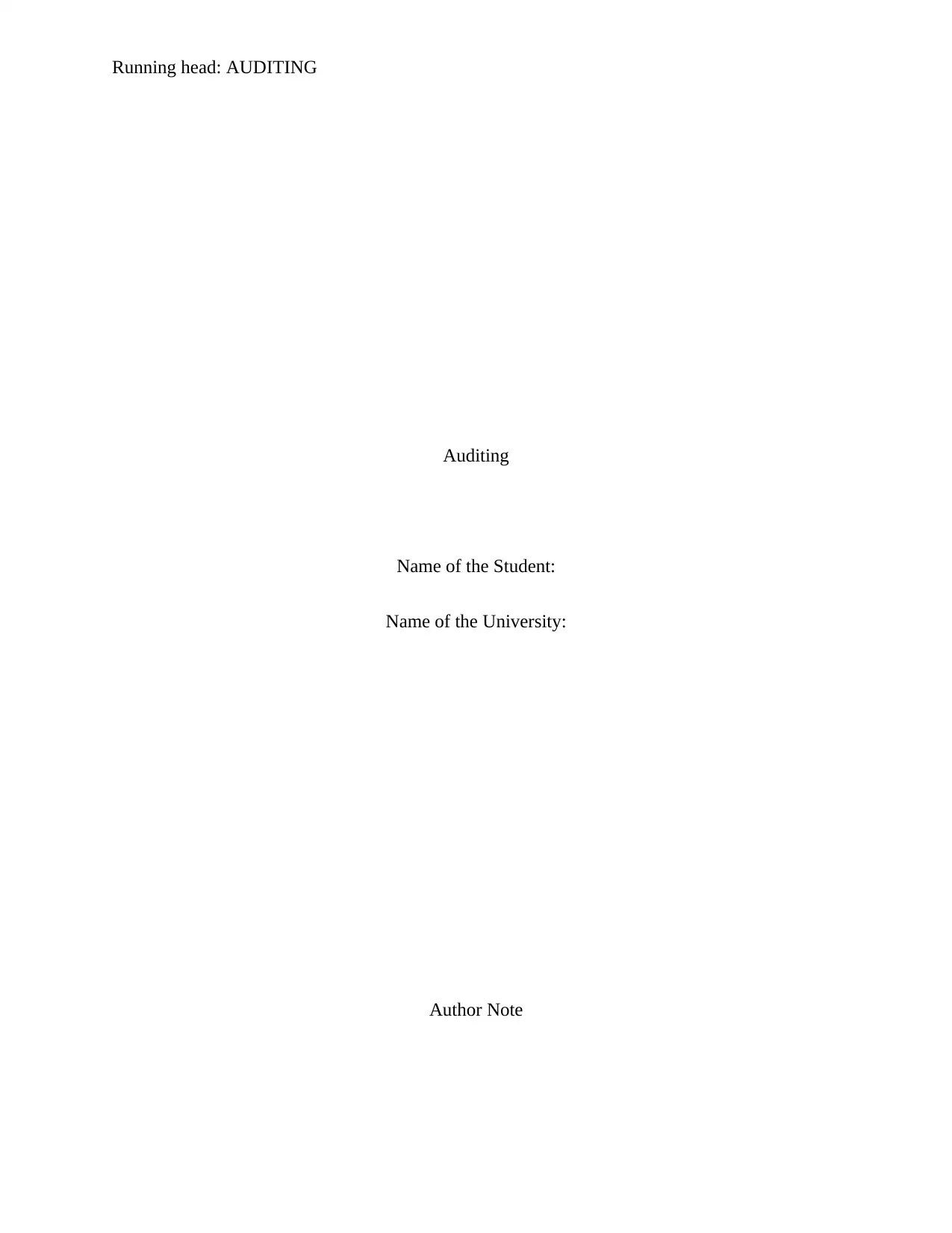
Running head: AUDITING
Auditing
Name of the Student:
Name of the University:
Author Note
Auditing
Name of the Student:
Name of the University:
Author Note
Paraphrase This Document
Need a fresh take? Get an instant paraphrase of this document with our AI Paraphraser
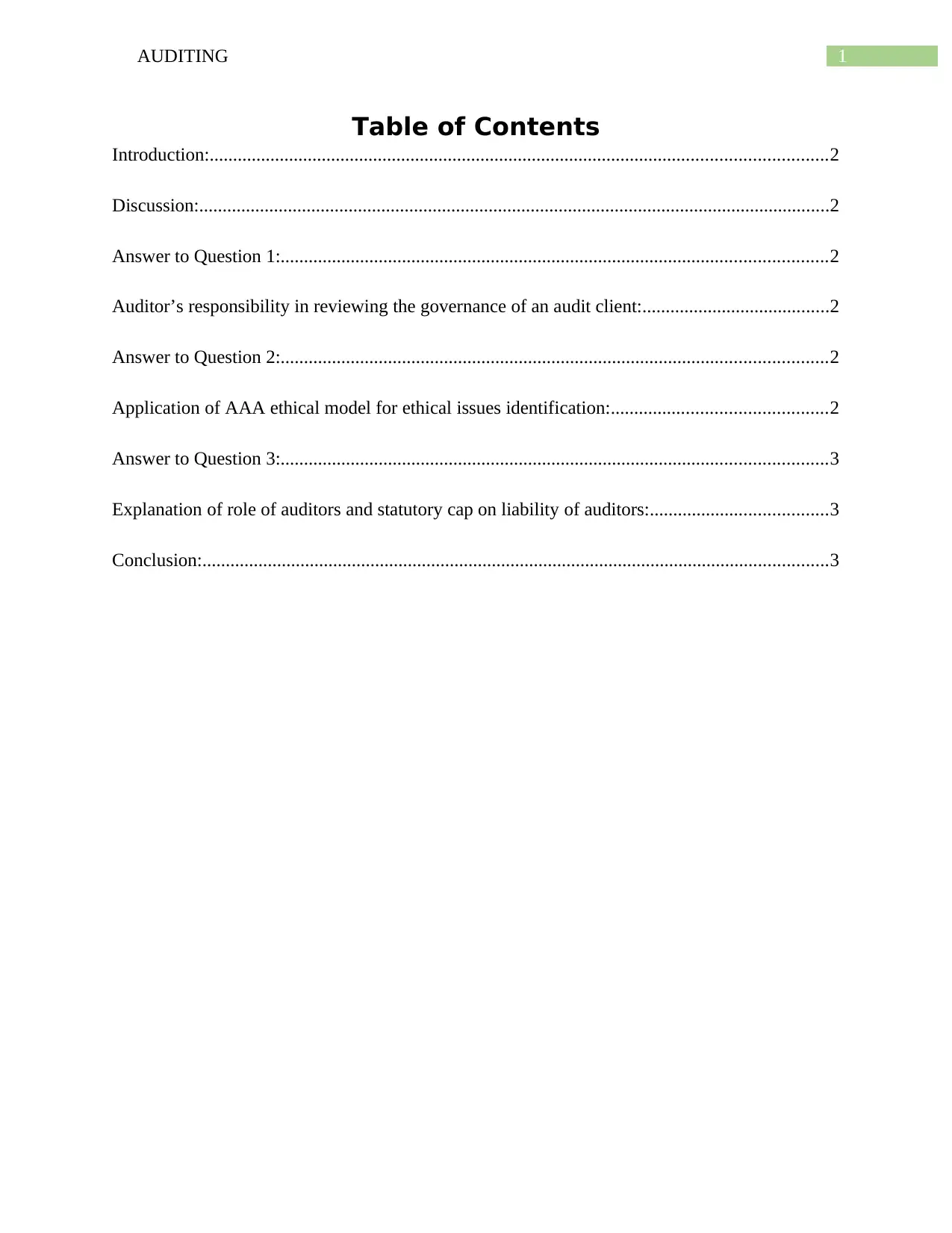
1AUDITING
Table of Contents
Introduction:....................................................................................................................................2
Discussion:.......................................................................................................................................2
Answer to Question 1:.....................................................................................................................2
Auditor’s responsibility in reviewing the governance of an audit client:........................................2
Answer to Question 2:.....................................................................................................................2
Application of AAA ethical model for ethical issues identification:..............................................2
Answer to Question 3:.....................................................................................................................3
Explanation of role of auditors and statutory cap on liability of auditors:......................................3
Conclusion:......................................................................................................................................3
Table of Contents
Introduction:....................................................................................................................................2
Discussion:.......................................................................................................................................2
Answer to Question 1:.....................................................................................................................2
Auditor’s responsibility in reviewing the governance of an audit client:........................................2
Answer to Question 2:.....................................................................................................................2
Application of AAA ethical model for ethical issues identification:..............................................2
Answer to Question 3:.....................................................................................................................3
Explanation of role of auditors and statutory cap on liability of auditors:......................................3
Conclusion:......................................................................................................................................3
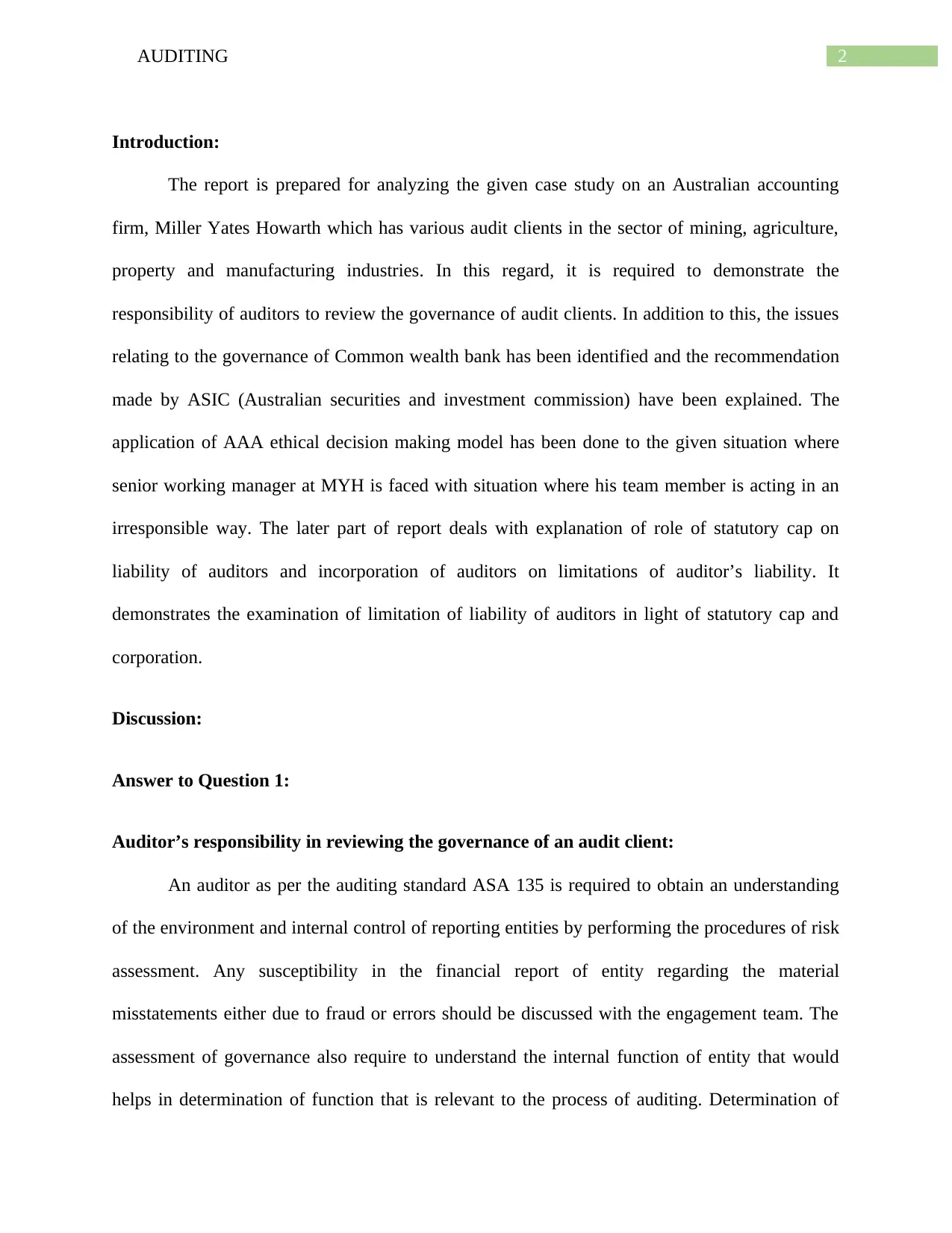
2AUDITING
Introduction:
The report is prepared for analyzing the given case study on an Australian accounting
firm, Miller Yates Howarth which has various audit clients in the sector of mining, agriculture,
property and manufacturing industries. In this regard, it is required to demonstrate the
responsibility of auditors to review the governance of audit clients. In addition to this, the issues
relating to the governance of Common wealth bank has been identified and the recommendation
made by ASIC (Australian securities and investment commission) have been explained. The
application of AAA ethical decision making model has been done to the given situation where
senior working manager at MYH is faced with situation where his team member is acting in an
irresponsible way. The later part of report deals with explanation of role of statutory cap on
liability of auditors and incorporation of auditors on limitations of auditor’s liability. It
demonstrates the examination of limitation of liability of auditors in light of statutory cap and
corporation.
Discussion:
Answer to Question 1:
Auditor’s responsibility in reviewing the governance of an audit client:
An auditor as per the auditing standard ASA 135 is required to obtain an understanding
of the environment and internal control of reporting entities by performing the procedures of risk
assessment. Any susceptibility in the financial report of entity regarding the material
misstatements either due to fraud or errors should be discussed with the engagement team. The
assessment of governance also require to understand the internal function of entity that would
helps in determination of function that is relevant to the process of auditing. Determination of
Introduction:
The report is prepared for analyzing the given case study on an Australian accounting
firm, Miller Yates Howarth which has various audit clients in the sector of mining, agriculture,
property and manufacturing industries. In this regard, it is required to demonstrate the
responsibility of auditors to review the governance of audit clients. In addition to this, the issues
relating to the governance of Common wealth bank has been identified and the recommendation
made by ASIC (Australian securities and investment commission) have been explained. The
application of AAA ethical decision making model has been done to the given situation where
senior working manager at MYH is faced with situation where his team member is acting in an
irresponsible way. The later part of report deals with explanation of role of statutory cap on
liability of auditors and incorporation of auditors on limitations of auditor’s liability. It
demonstrates the examination of limitation of liability of auditors in light of statutory cap and
corporation.
Discussion:
Answer to Question 1:
Auditor’s responsibility in reviewing the governance of an audit client:
An auditor as per the auditing standard ASA 135 is required to obtain an understanding
of the environment and internal control of reporting entities by performing the procedures of risk
assessment. Any susceptibility in the financial report of entity regarding the material
misstatements either due to fraud or errors should be discussed with the engagement team. The
assessment of governance also require to understand the internal function of entity that would
helps in determination of function that is relevant to the process of auditing. Determination of
⊘ This is a preview!⊘
Do you want full access?
Subscribe today to unlock all pages.

Trusted by 1+ million students worldwide
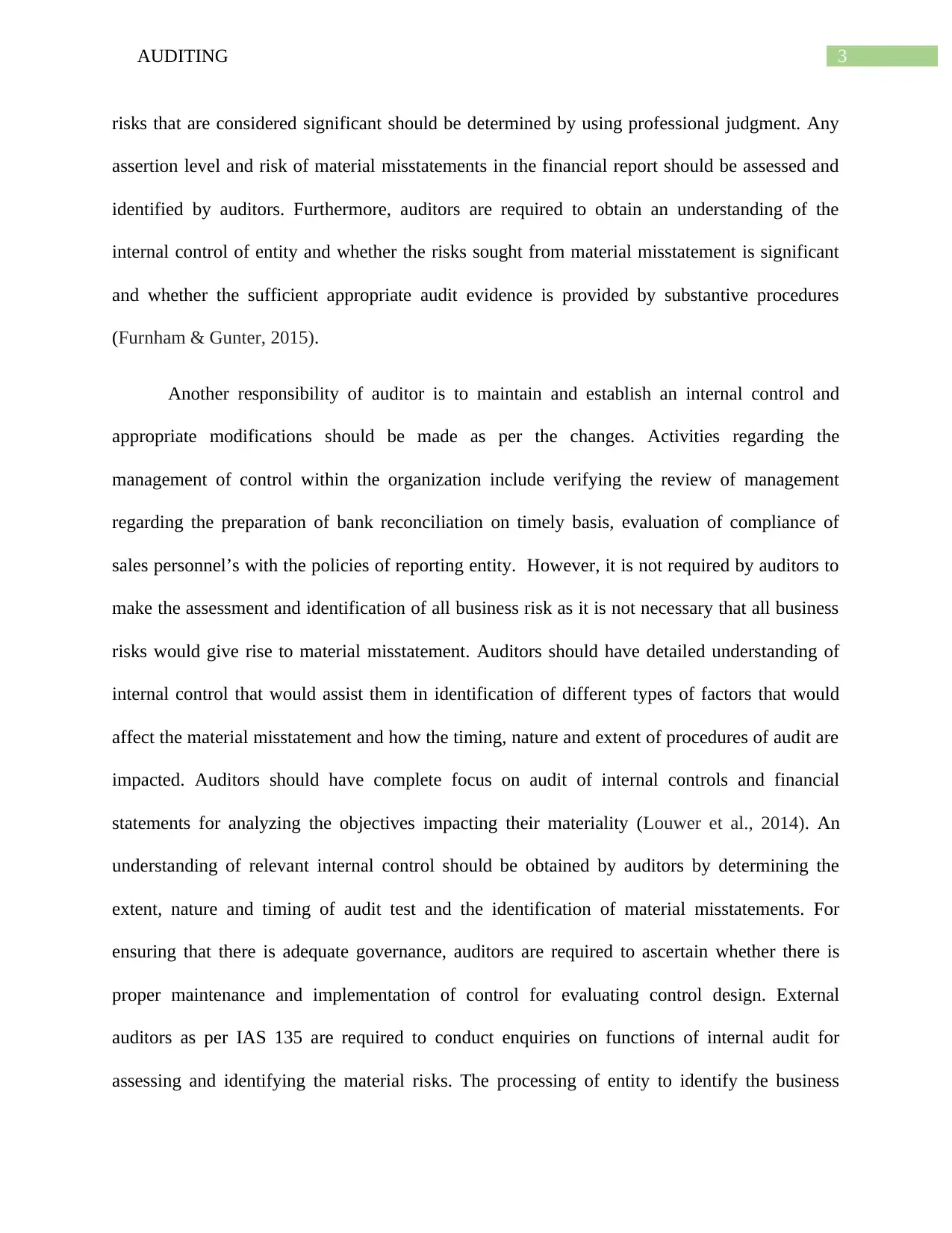
3AUDITING
risks that are considered significant should be determined by using professional judgment. Any
assertion level and risk of material misstatements in the financial report should be assessed and
identified by auditors. Furthermore, auditors are required to obtain an understanding of the
internal control of entity and whether the risks sought from material misstatement is significant
and whether the sufficient appropriate audit evidence is provided by substantive procedures
(Furnham & Gunter, 2015).
Another responsibility of auditor is to maintain and establish an internal control and
appropriate modifications should be made as per the changes. Activities regarding the
management of control within the organization include verifying the review of management
regarding the preparation of bank reconciliation on timely basis, evaluation of compliance of
sales personnel’s with the policies of reporting entity. However, it is not required by auditors to
make the assessment and identification of all business risk as it is not necessary that all business
risks would give rise to material misstatement. Auditors should have detailed understanding of
internal control that would assist them in identification of different types of factors that would
affect the material misstatement and how the timing, nature and extent of procedures of audit are
impacted. Auditors should have complete focus on audit of internal controls and financial
statements for analyzing the objectives impacting their materiality (Louwer et al., 2014). An
understanding of relevant internal control should be obtained by auditors by determining the
extent, nature and timing of audit test and the identification of material misstatements. For
ensuring that there is adequate governance, auditors are required to ascertain whether there is
proper maintenance and implementation of control for evaluating control design. External
auditors as per IAS 135 are required to conduct enquiries on functions of internal audit for
assessing and identifying the material risks. The processing of entity to identify the business
risks that are considered significant should be determined by using professional judgment. Any
assertion level and risk of material misstatements in the financial report should be assessed and
identified by auditors. Furthermore, auditors are required to obtain an understanding of the
internal control of entity and whether the risks sought from material misstatement is significant
and whether the sufficient appropriate audit evidence is provided by substantive procedures
(Furnham & Gunter, 2015).
Another responsibility of auditor is to maintain and establish an internal control and
appropriate modifications should be made as per the changes. Activities regarding the
management of control within the organization include verifying the review of management
regarding the preparation of bank reconciliation on timely basis, evaluation of compliance of
sales personnel’s with the policies of reporting entity. However, it is not required by auditors to
make the assessment and identification of all business risk as it is not necessary that all business
risks would give rise to material misstatement. Auditors should have detailed understanding of
internal control that would assist them in identification of different types of factors that would
affect the material misstatement and how the timing, nature and extent of procedures of audit are
impacted. Auditors should have complete focus on audit of internal controls and financial
statements for analyzing the objectives impacting their materiality (Louwer et al., 2014). An
understanding of relevant internal control should be obtained by auditors by determining the
extent, nature and timing of audit test and the identification of material misstatements. For
ensuring that there is adequate governance, auditors are required to ascertain whether there is
proper maintenance and implementation of control for evaluating control design. External
auditors as per IAS 135 are required to conduct enquiries on functions of internal audit for
assessing and identifying the material risks. The processing of entity to identify the business
Paraphrase This Document
Need a fresh take? Get an instant paraphrase of this document with our AI Paraphraser
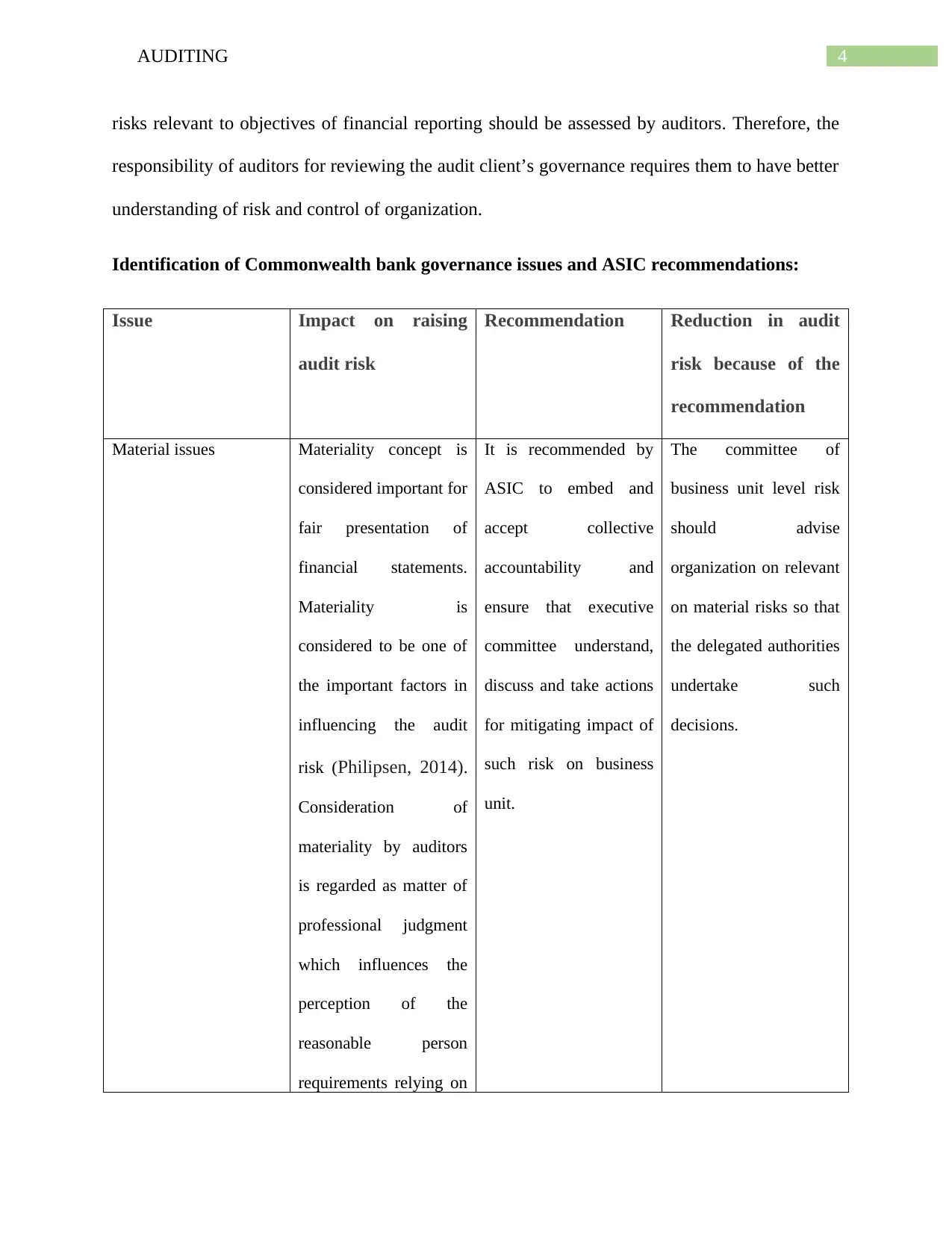
4AUDITING
risks relevant to objectives of financial reporting should be assessed by auditors. Therefore, the
responsibility of auditors for reviewing the audit client’s governance requires them to have better
understanding of risk and control of organization.
Identification of Commonwealth bank governance issues and ASIC recommendations:
Issue Impact on raising
audit risk
Recommendation Reduction in audit
risk because of the
recommendation
Material issues Materiality concept is
considered important for
fair presentation of
financial statements.
Materiality is
considered to be one of
the important factors in
influencing the audit
risk (Philipsen, 2014).
Consideration of
materiality by auditors
is regarded as matter of
professional judgment
which influences the
perception of the
reasonable person
requirements relying on
It is recommended by
ASIC to embed and
accept collective
accountability and
ensure that executive
committee understand,
discuss and take actions
for mitigating impact of
such risk on business
unit.
The committee of
business unit level risk
should advise
organization on relevant
on material risks so that
the delegated authorities
undertake such
decisions.
risks relevant to objectives of financial reporting should be assessed by auditors. Therefore, the
responsibility of auditors for reviewing the audit client’s governance requires them to have better
understanding of risk and control of organization.
Identification of Commonwealth bank governance issues and ASIC recommendations:
Issue Impact on raising
audit risk
Recommendation Reduction in audit
risk because of the
recommendation
Material issues Materiality concept is
considered important for
fair presentation of
financial statements.
Materiality is
considered to be one of
the important factors in
influencing the audit
risk (Philipsen, 2014).
Consideration of
materiality by auditors
is regarded as matter of
professional judgment
which influences the
perception of the
reasonable person
requirements relying on
It is recommended by
ASIC to embed and
accept collective
accountability and
ensure that executive
committee understand,
discuss and take actions
for mitigating impact of
such risk on business
unit.
The committee of
business unit level risk
should advise
organization on relevant
on material risks so that
the delegated authorities
undertake such
decisions.
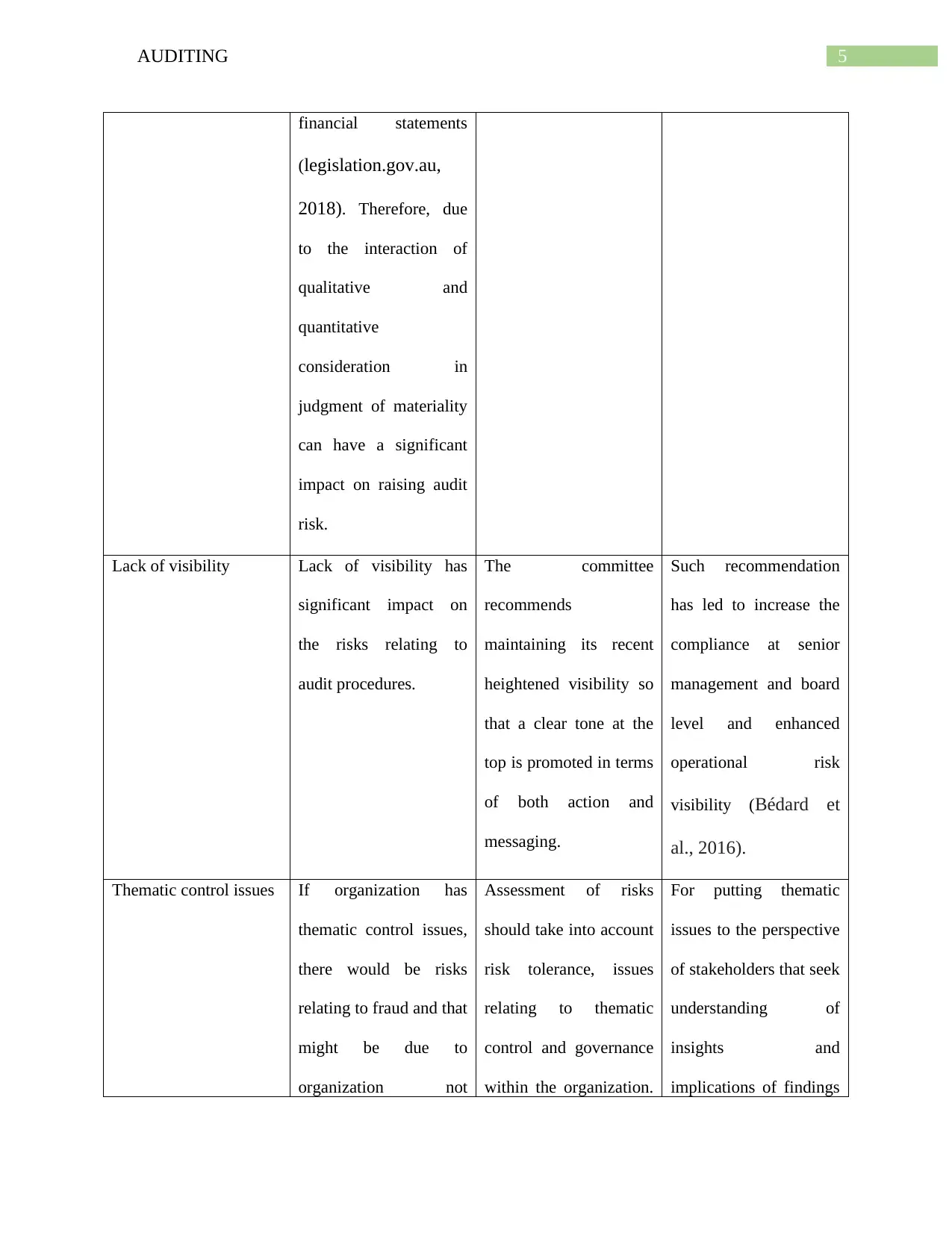
5AUDITING
financial statements
(legislation.gov.au,
2018). Therefore, due
to the interaction of
qualitative and
quantitative
consideration in
judgment of materiality
can have a significant
impact on raising audit
risk.
Lack of visibility Lack of visibility has
significant impact on
the risks relating to
audit procedures.
The committee
recommends
maintaining its recent
heightened visibility so
that a clear tone at the
top is promoted in terms
of both action and
messaging.
Such recommendation
has led to increase the
compliance at senior
management and board
level and enhanced
operational risk
visibility (Bédard et
al., 2016).
Thematic control issues If organization has
thematic control issues,
there would be risks
relating to fraud and that
might be due to
organization not
Assessment of risks
should take into account
risk tolerance, issues
relating to thematic
control and governance
within the organization.
For putting thematic
issues to the perspective
of stakeholders that seek
understanding of
insights and
implications of findings
financial statements
(legislation.gov.au,
2018). Therefore, due
to the interaction of
qualitative and
quantitative
consideration in
judgment of materiality
can have a significant
impact on raising audit
risk.
Lack of visibility Lack of visibility has
significant impact on
the risks relating to
audit procedures.
The committee
recommends
maintaining its recent
heightened visibility so
that a clear tone at the
top is promoted in terms
of both action and
messaging.
Such recommendation
has led to increase the
compliance at senior
management and board
level and enhanced
operational risk
visibility (Bédard et
al., 2016).
Thematic control issues If organization has
thematic control issues,
there would be risks
relating to fraud and that
might be due to
organization not
Assessment of risks
should take into account
risk tolerance, issues
relating to thematic
control and governance
within the organization.
For putting thematic
issues to the perspective
of stakeholders that seek
understanding of
insights and
implications of findings
⊘ This is a preview!⊘
Do you want full access?
Subscribe today to unlock all pages.

Trusted by 1+ million students worldwide
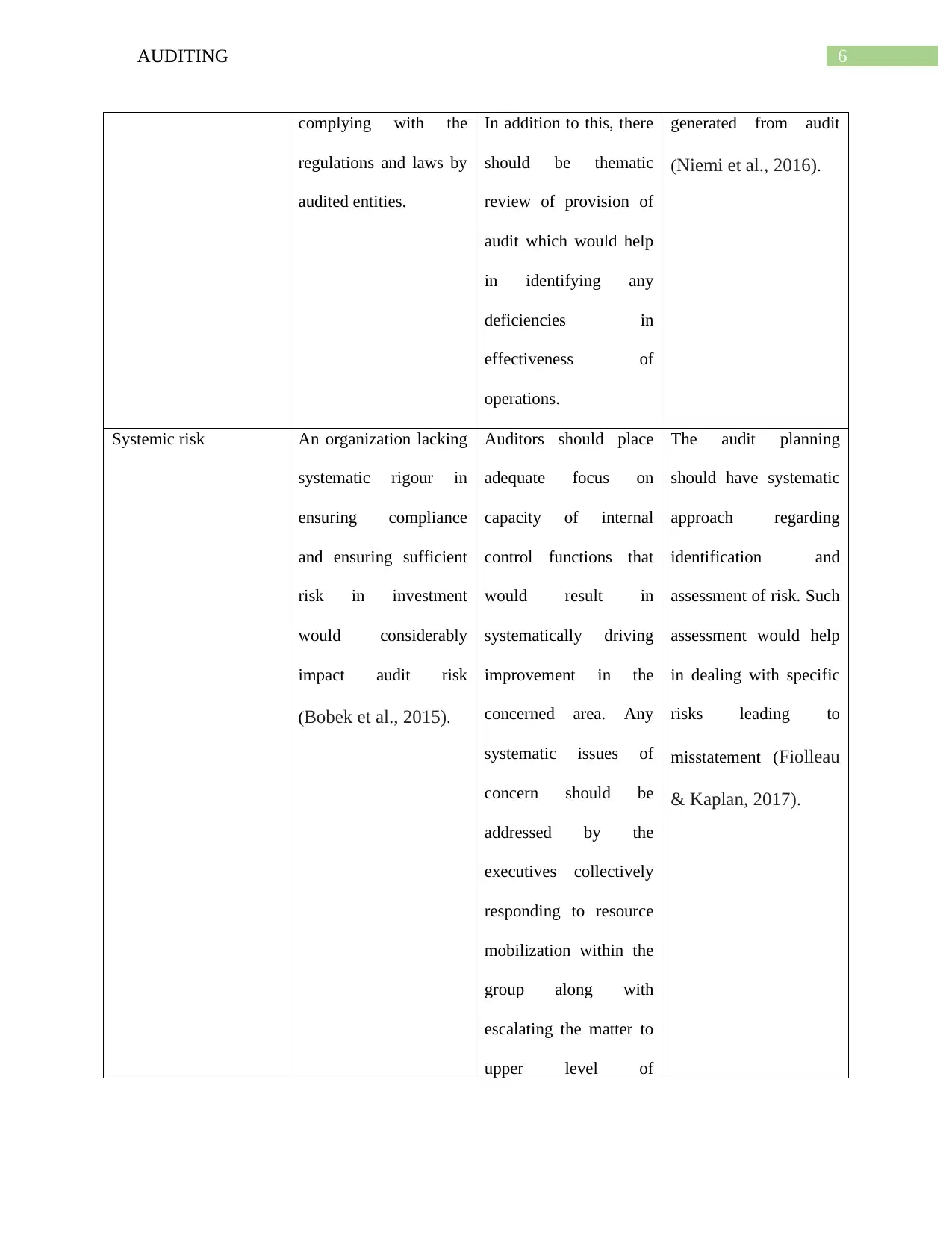
6AUDITING
complying with the
regulations and laws by
audited entities.
In addition to this, there
should be thematic
review of provision of
audit which would help
in identifying any
deficiencies in
effectiveness of
operations.
generated from audit
(Niemi et al., 2016).
Systemic risk An organization lacking
systematic rigour in
ensuring compliance
and ensuring sufficient
risk in investment
would considerably
impact audit risk
(Bobek et al., 2015).
Auditors should place
adequate focus on
capacity of internal
control functions that
would result in
systematically driving
improvement in the
concerned area. Any
systematic issues of
concern should be
addressed by the
executives collectively
responding to resource
mobilization within the
group along with
escalating the matter to
upper level of
The audit planning
should have systematic
approach regarding
identification and
assessment of risk. Such
assessment would help
in dealing with specific
risks leading to
misstatement (Fiolleau
& Kaplan, 2017).
complying with the
regulations and laws by
audited entities.
In addition to this, there
should be thematic
review of provision of
audit which would help
in identifying any
deficiencies in
effectiveness of
operations.
generated from audit
(Niemi et al., 2016).
Systemic risk An organization lacking
systematic rigour in
ensuring compliance
and ensuring sufficient
risk in investment
would considerably
impact audit risk
(Bobek et al., 2015).
Auditors should place
adequate focus on
capacity of internal
control functions that
would result in
systematically driving
improvement in the
concerned area. Any
systematic issues of
concern should be
addressed by the
executives collectively
responding to resource
mobilization within the
group along with
escalating the matter to
upper level of
The audit planning
should have systematic
approach regarding
identification and
assessment of risk. Such
assessment would help
in dealing with specific
risks leading to
misstatement (Fiolleau
& Kaplan, 2017).
Paraphrase This Document
Need a fresh take? Get an instant paraphrase of this document with our AI Paraphraser
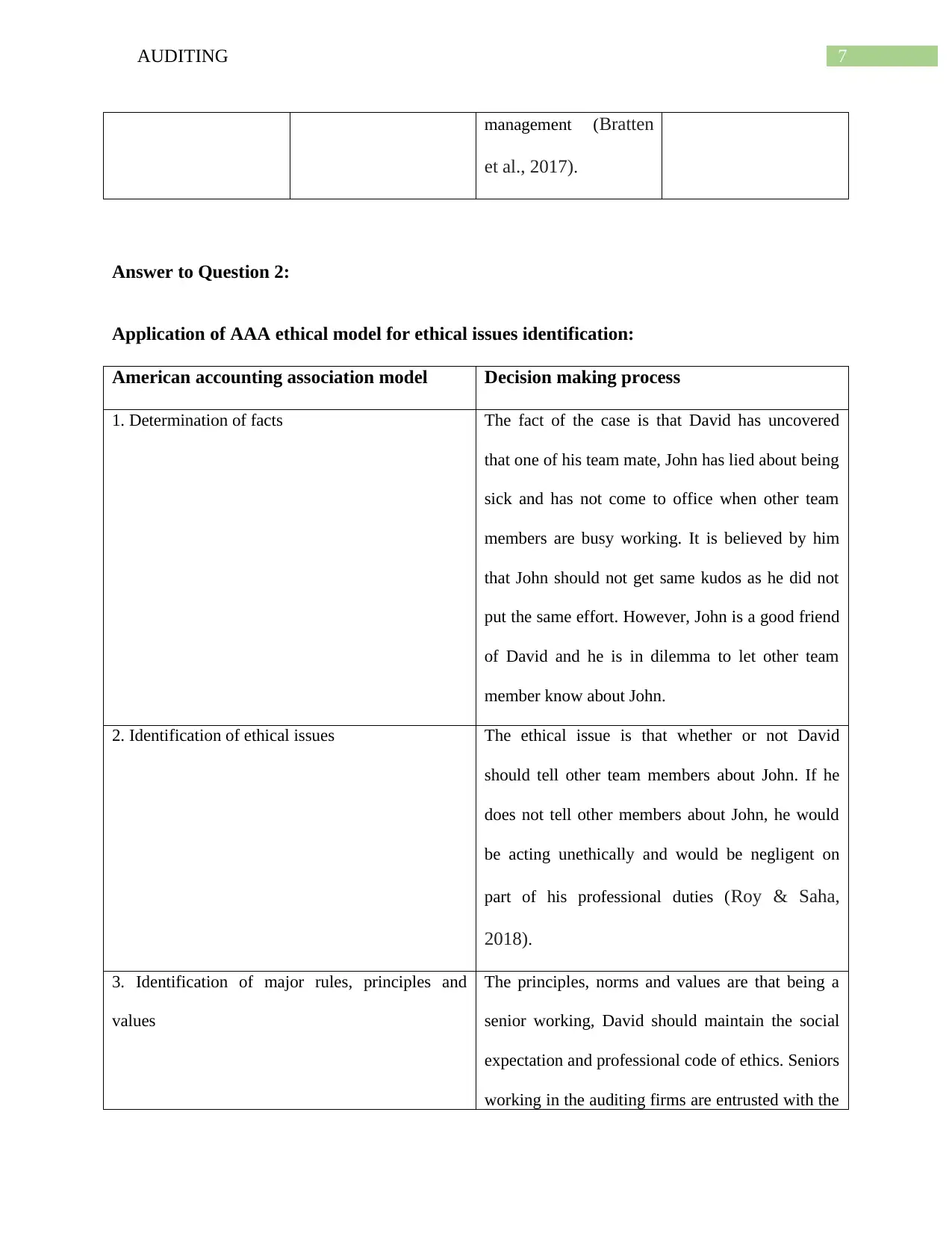
7AUDITING
management (Bratten
et al., 2017).
Answer to Question 2:
Application of AAA ethical model for ethical issues identification:
American accounting association model Decision making process
1. Determination of facts The fact of the case is that David has uncovered
that one of his team mate, John has lied about being
sick and has not come to office when other team
members are busy working. It is believed by him
that John should not get same kudos as he did not
put the same effort. However, John is a good friend
of David and he is in dilemma to let other team
member know about John.
2. Identification of ethical issues The ethical issue is that whether or not David
should tell other team members about John. If he
does not tell other members about John, he would
be acting unethically and would be negligent on
part of his professional duties (Roy & Saha,
2018).
3. Identification of major rules, principles and
values
The principles, norms and values are that being a
senior working, David should maintain the social
expectation and professional code of ethics. Seniors
working in the auditing firms are entrusted with the
management (Bratten
et al., 2017).
Answer to Question 2:
Application of AAA ethical model for ethical issues identification:
American accounting association model Decision making process
1. Determination of facts The fact of the case is that David has uncovered
that one of his team mate, John has lied about being
sick and has not come to office when other team
members are busy working. It is believed by him
that John should not get same kudos as he did not
put the same effort. However, John is a good friend
of David and he is in dilemma to let other team
member know about John.
2. Identification of ethical issues The ethical issue is that whether or not David
should tell other team members about John. If he
does not tell other members about John, he would
be acting unethically and would be negligent on
part of his professional duties (Roy & Saha,
2018).
3. Identification of major rules, principles and
values
The principles, norms and values are that being a
senior working, David should maintain the social
expectation and professional code of ethics. Seniors
working in the auditing firms are entrusted with the
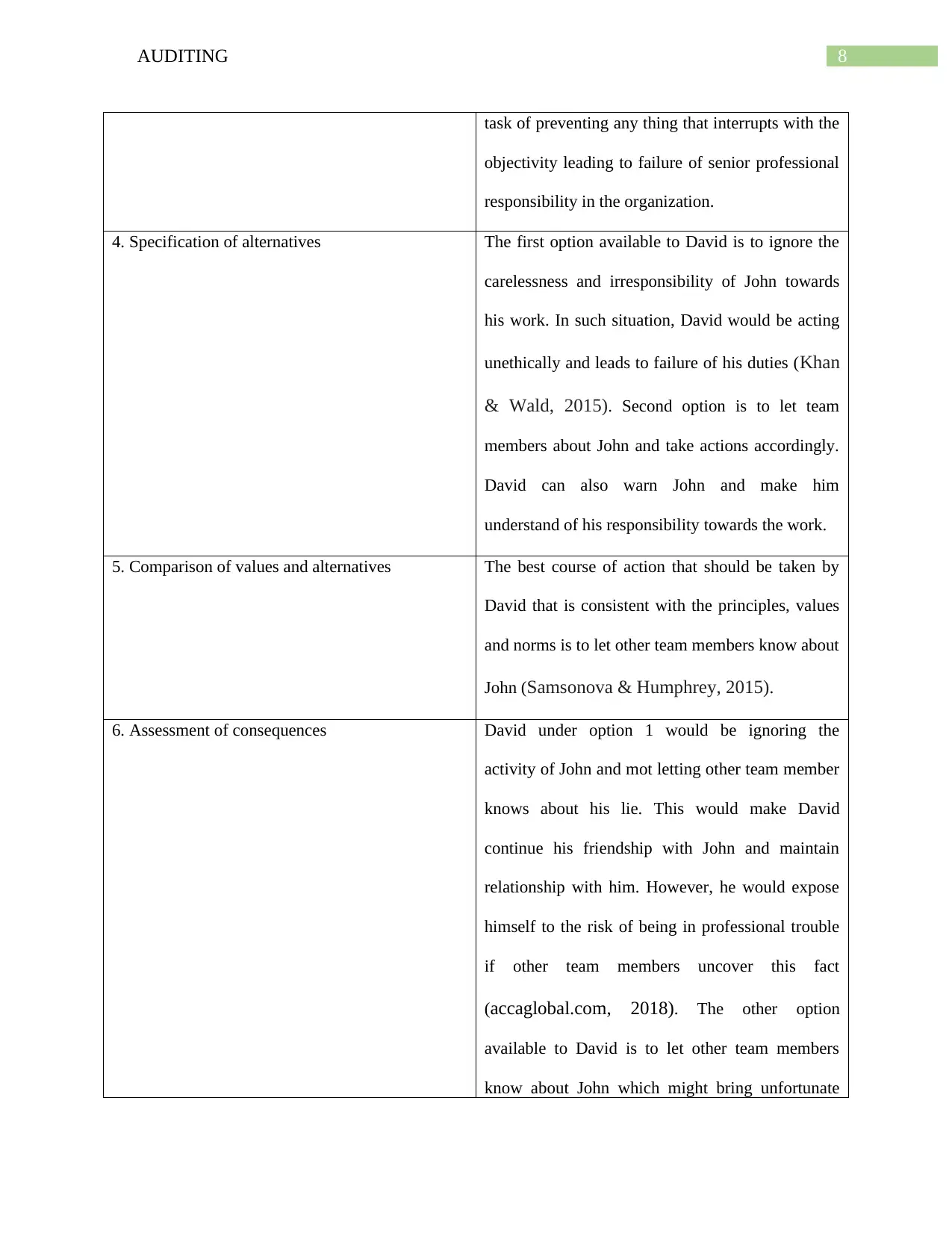
8AUDITING
task of preventing any thing that interrupts with the
objectivity leading to failure of senior professional
responsibility in the organization.
4. Specification of alternatives The first option available to David is to ignore the
carelessness and irresponsibility of John towards
his work. In such situation, David would be acting
unethically and leads to failure of his duties (Khan
& Wald, 2015). Second option is to let team
members about John and take actions accordingly.
David can also warn John and make him
understand of his responsibility towards the work.
5. Comparison of values and alternatives The best course of action that should be taken by
David that is consistent with the principles, values
and norms is to let other team members know about
John (Samsonova & Humphrey, 2015).
6. Assessment of consequences David under option 1 would be ignoring the
activity of John and mot letting other team member
knows about his lie. This would make David
continue his friendship with John and maintain
relationship with him. However, he would expose
himself to the risk of being in professional trouble
if other team members uncover this fact
(accaglobal.com, 2018). The other option
available to David is to let other team members
know about John which might bring unfortunate
task of preventing any thing that interrupts with the
objectivity leading to failure of senior professional
responsibility in the organization.
4. Specification of alternatives The first option available to David is to ignore the
carelessness and irresponsibility of John towards
his work. In such situation, David would be acting
unethically and leads to failure of his duties (Khan
& Wald, 2015). Second option is to let team
members about John and take actions accordingly.
David can also warn John and make him
understand of his responsibility towards the work.
5. Comparison of values and alternatives The best course of action that should be taken by
David that is consistent with the principles, values
and norms is to let other team members know about
John (Samsonova & Humphrey, 2015).
6. Assessment of consequences David under option 1 would be ignoring the
activity of John and mot letting other team member
knows about his lie. This would make David
continue his friendship with John and maintain
relationship with him. However, he would expose
himself to the risk of being in professional trouble
if other team members uncover this fact
(accaglobal.com, 2018). The other option
available to David is to let other team members
know about John which might bring unfortunate
⊘ This is a preview!⊘
Do you want full access?
Subscribe today to unlock all pages.

Trusted by 1+ million students worldwide
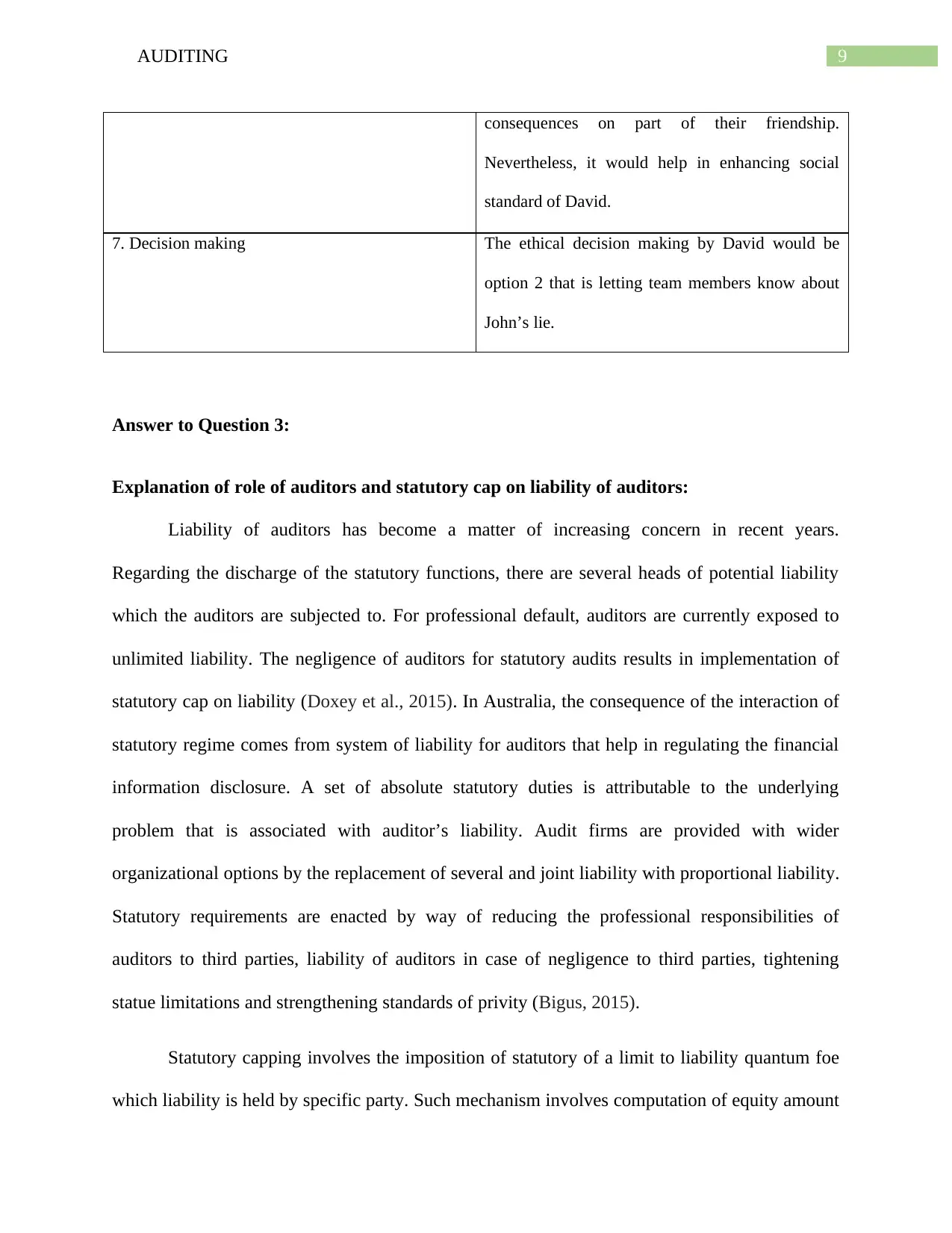
9AUDITING
consequences on part of their friendship.
Nevertheless, it would help in enhancing social
standard of David.
7. Decision making The ethical decision making by David would be
option 2 that is letting team members know about
John’s lie.
Answer to Question 3:
Explanation of role of auditors and statutory cap on liability of auditors:
Liability of auditors has become a matter of increasing concern in recent years.
Regarding the discharge of the statutory functions, there are several heads of potential liability
which the auditors are subjected to. For professional default, auditors are currently exposed to
unlimited liability. The negligence of auditors for statutory audits results in implementation of
statutory cap on liability (Doxey et al., 2015). In Australia, the consequence of the interaction of
statutory regime comes from system of liability for auditors that help in regulating the financial
information disclosure. A set of absolute statutory duties is attributable to the underlying
problem that is associated with auditor’s liability. Audit firms are provided with wider
organizational options by the replacement of several and joint liability with proportional liability.
Statutory requirements are enacted by way of reducing the professional responsibilities of
auditors to third parties, liability of auditors in case of negligence to third parties, tightening
statue limitations and strengthening standards of privity (Bigus, 2015).
Statutory capping involves the imposition of statutory of a limit to liability quantum foe
which liability is held by specific party. Such mechanism involves computation of equity amount
consequences on part of their friendship.
Nevertheless, it would help in enhancing social
standard of David.
7. Decision making The ethical decision making by David would be
option 2 that is letting team members know about
John’s lie.
Answer to Question 3:
Explanation of role of auditors and statutory cap on liability of auditors:
Liability of auditors has become a matter of increasing concern in recent years.
Regarding the discharge of the statutory functions, there are several heads of potential liability
which the auditors are subjected to. For professional default, auditors are currently exposed to
unlimited liability. The negligence of auditors for statutory audits results in implementation of
statutory cap on liability (Doxey et al., 2015). In Australia, the consequence of the interaction of
statutory regime comes from system of liability for auditors that help in regulating the financial
information disclosure. A set of absolute statutory duties is attributable to the underlying
problem that is associated with auditor’s liability. Audit firms are provided with wider
organizational options by the replacement of several and joint liability with proportional liability.
Statutory requirements are enacted by way of reducing the professional responsibilities of
auditors to third parties, liability of auditors in case of negligence to third parties, tightening
statue limitations and strengthening standards of privity (Bigus, 2015).
Statutory capping involves the imposition of statutory of a limit to liability quantum foe
which liability is held by specific party. Such mechanism involves computation of equity amount
Paraphrase This Document
Need a fresh take? Get an instant paraphrase of this document with our AI Paraphraser
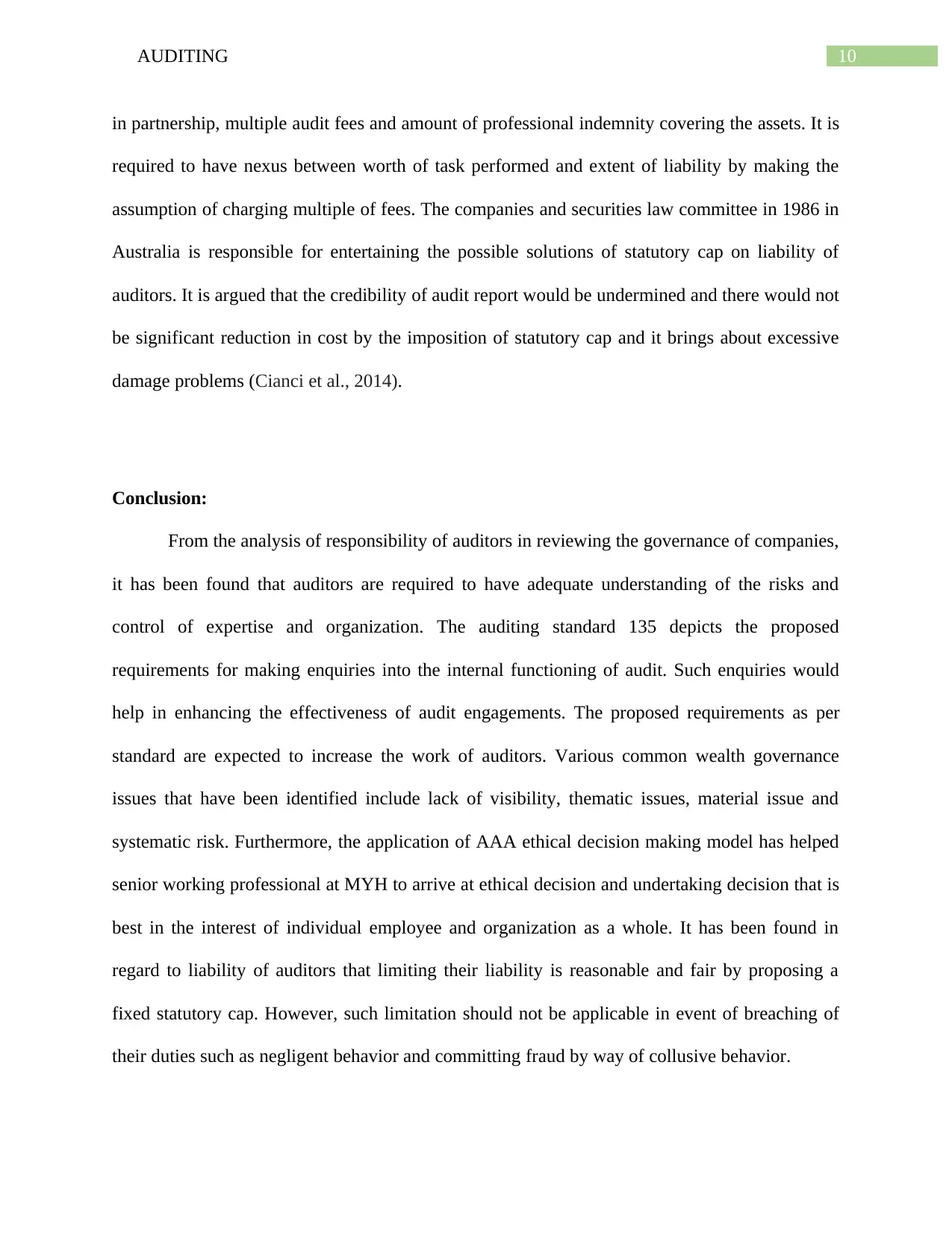
10AUDITING
in partnership, multiple audit fees and amount of professional indemnity covering the assets. It is
required to have nexus between worth of task performed and extent of liability by making the
assumption of charging multiple of fees. The companies and securities law committee in 1986 in
Australia is responsible for entertaining the possible solutions of statutory cap on liability of
auditors. It is argued that the credibility of audit report would be undermined and there would not
be significant reduction in cost by the imposition of statutory cap and it brings about excessive
damage problems (Cianci et al., 2014).
Conclusion:
From the analysis of responsibility of auditors in reviewing the governance of companies,
it has been found that auditors are required to have adequate understanding of the risks and
control of expertise and organization. The auditing standard 135 depicts the proposed
requirements for making enquiries into the internal functioning of audit. Such enquiries would
help in enhancing the effectiveness of audit engagements. The proposed requirements as per
standard are expected to increase the work of auditors. Various common wealth governance
issues that have been identified include lack of visibility, thematic issues, material issue and
systematic risk. Furthermore, the application of AAA ethical decision making model has helped
senior working professional at MYH to arrive at ethical decision and undertaking decision that is
best in the interest of individual employee and organization as a whole. It has been found in
regard to liability of auditors that limiting their liability is reasonable and fair by proposing a
fixed statutory cap. However, such limitation should not be applicable in event of breaching of
their duties such as negligent behavior and committing fraud by way of collusive behavior.
in partnership, multiple audit fees and amount of professional indemnity covering the assets. It is
required to have nexus between worth of task performed and extent of liability by making the
assumption of charging multiple of fees. The companies and securities law committee in 1986 in
Australia is responsible for entertaining the possible solutions of statutory cap on liability of
auditors. It is argued that the credibility of audit report would be undermined and there would not
be significant reduction in cost by the imposition of statutory cap and it brings about excessive
damage problems (Cianci et al., 2014).
Conclusion:
From the analysis of responsibility of auditors in reviewing the governance of companies,
it has been found that auditors are required to have adequate understanding of the risks and
control of expertise and organization. The auditing standard 135 depicts the proposed
requirements for making enquiries into the internal functioning of audit. Such enquiries would
help in enhancing the effectiveness of audit engagements. The proposed requirements as per
standard are expected to increase the work of auditors. Various common wealth governance
issues that have been identified include lack of visibility, thematic issues, material issue and
systematic risk. Furthermore, the application of AAA ethical decision making model has helped
senior working professional at MYH to arrive at ethical decision and undertaking decision that is
best in the interest of individual employee and organization as a whole. It has been found in
regard to liability of auditors that limiting their liability is reasonable and fair by proposing a
fixed statutory cap. However, such limitation should not be applicable in event of breaching of
their duties such as negligent behavior and committing fraud by way of collusive behavior.
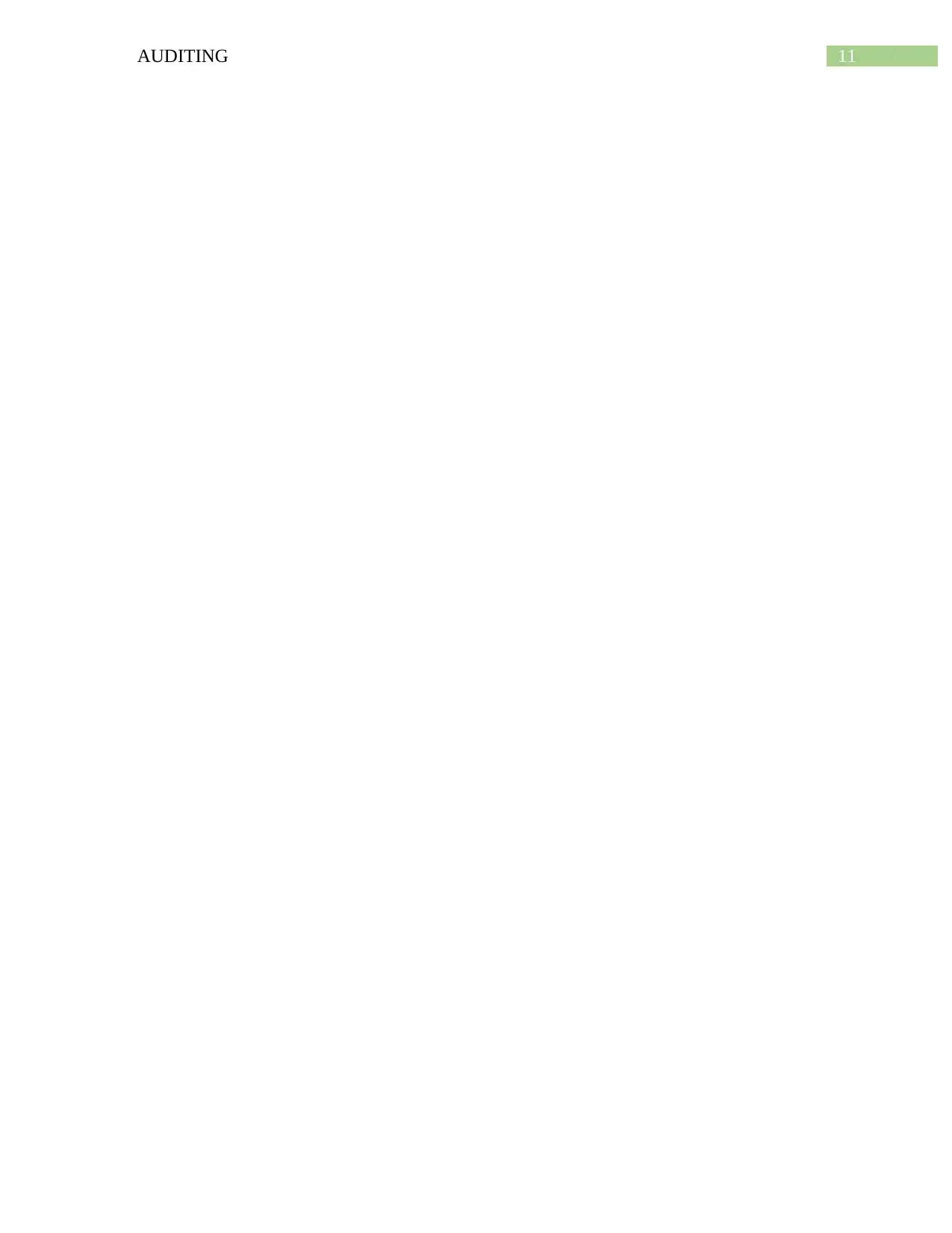
11AUDITING
⊘ This is a preview!⊘
Do you want full access?
Subscribe today to unlock all pages.

Trusted by 1+ million students worldwide
1 out of 13
Related Documents
Your All-in-One AI-Powered Toolkit for Academic Success.
+13062052269
info@desklib.com
Available 24*7 on WhatsApp / Email
![[object Object]](/_next/static/media/star-bottom.7253800d.svg)
Unlock your academic potential
Copyright © 2020–2025 A2Z Services. All Rights Reserved. Developed and managed by ZUCOL.


